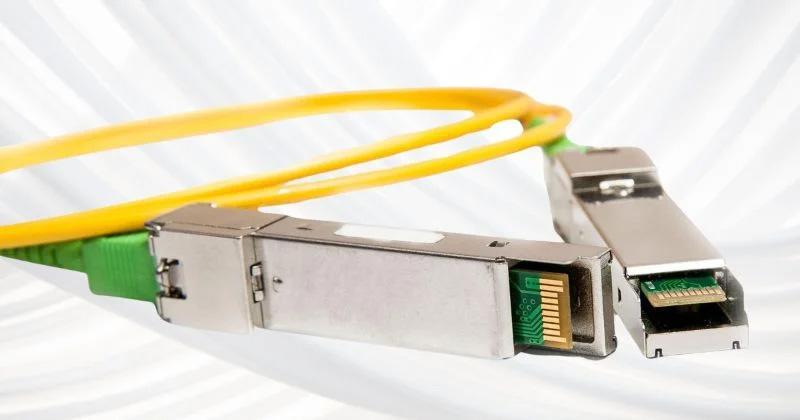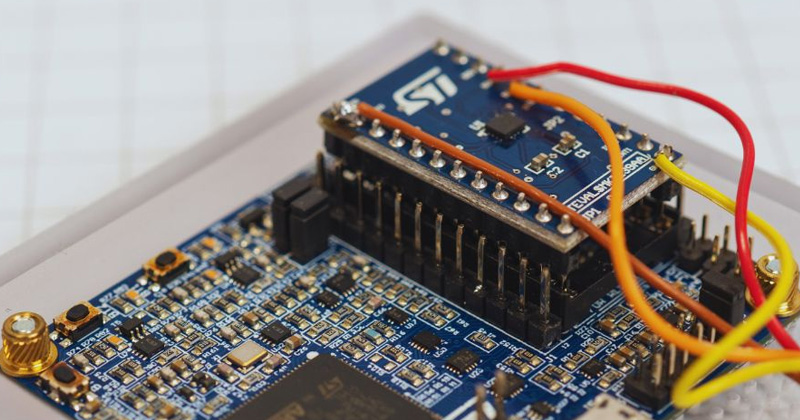
Ultimate Guide to SMD Resistors: Identification, Dimensions, Testing, and Selection
SMD resistors, also known as chip fixed resistors, are one of the metal-glass glaze resistors. They are manufactured by mixing metal powder and glass glaze powder and printing them on a substrate using the screen printing method. These resistors are resistant to humidity and high temperatures and have a low-temperature coefficient. SMD resistors can significantly reduce the cost of circuit space and enhance the design's refinement.
Resistor SMD Code
Abstract
An SMD resistor, also known as a chip fixed resistor, is one of the metal glass glaze resistors. It is a resistor made by mixing metal powder and glass glaze powder and printing on the substrate by the screen printing method. It is resistant to humidity and high temperature with a low-temperature coefficient. SMD resistors can significantly reduce the cost of circuit space and enhance the design's overall refinement. SMD stands for Surface Mounted Devices, which is a special kind of SMT (Surface Mount Technology) element device. SMD resistors are usually called chip resistors.
Catalog
I. How to identify SMD resistor codes?
1. Digital cable nominal method (generally used for rectangular chip resistors)
2. Nominal color ring method (generally used for cylindrical fixed resistors)
3. E96 digital code and letter mixed nominal method
II SMD resistor size
III SMD resistor testing method
IV SMD resistor tolerance
V SMD resistor selection
I How to identify SMD resistor codes?
1. Digital cable nominal method (generally used for rectangular chip resistors)

SMD resistor
The first and second digits are significant digits, while the third digit represents the number of "0"s added after the significant digit. No letters appear in this format. For example, "472" means "4700Ω," while "151" means "150."
The resistance value of the SMD resistor is prominently marked on its surface in digital form, facilitating easy identification of the resistor's rating. To further simplify the interpretation of these markings, designers and technicians can employ an smd resistor calculator. This tool efficiently converts the numerical codes present on the resistor surface into their actual resistance values, thereby streamlining the processes of electronic design and repair. With various representation methods available, including three-digit numerical codes and letter-numeric combinations, an smd resistor calculator becomes an indispensable utility for accurate and quick calculations, ensuring precision in electronic assembly and troubleshooting.
(1) Composed of three numbers, indicating that the tolerance of resistance is ± 5%. The first two digits are significant digits, the third digit represents the multiplying multiplier by zero, and the basic unit is Ω. For example, 10³, 1, and 0 are valid numbers. Please record these as such. 2 means multiplying by zero, which is the power of 10 (in short, the third digit is the power of 10). Therefore, the resistance represented by 103 is equal to 10 x 1000, or 10,000 Ω, which is commonly expressed as 10K Ω.
(2) Composed of four numbers, indicating that the tolerance of resistance is ± 1%. The first three digits are significant digits, and the fourth digit represents a multiplier by zero (that is, the number means the power of 10). For example, 1502, 150 is a significant number. Please enter it directly. 2 represents the power of 10. The resistance of 1502 is equal to the square of 150 multiplied by 10, which is 15000Ω. This can be expressed as 15KΩ.
(3) Composed of numbers and letters, such as 5R6, R16, etc. In this case, only the letter R needs to be replaced with a decimal point.
5R6 = 5.6R = 5.6Ω
R16 = 0.16R = 0.16Ω
It should be noted here that "R" is the expression of resistance and "Ω" is the expression of resistance unit. In daily life, we may not mix the two, but in industrial production, the boundary between the two is very vague.
2. Nominal color ring method (generally used for cylindrical fixed resistors)
The first and second rings indicate significant digits, while the third ring represents magnification. Table 1 provides an overview of color ring codes. For instance, "Brown Green Black" signifies "15Ω," while "Blue Gray Orange Silver" denotes "68kΩ" with a tolerance of ±10%.
3.E96 digital code and letter mixed nominal method
The mixed nominal method of digital codes and letters also uses three digits to indicate the resistance value, that is, "two digits plus one letter." Two digits represent the E96 series resistance code. The third digit is the magnification expressed by letter code (shown in Table). For example: "51D" represents "332 × 103; 332kΩ," while "249Y" stands for "249 × 10-2; 2.49Ω."
II SMD Resistor Size
Surface-mount resistors adhere to standardized dimensions, predominantly following the JEDEC standard, which is essential for ensuring compatibility and precision in design. The smd resistor dimensions, indicated by a digital code such as 0603, are crucial for designers as they select components that fit within the constraints of their circuit layouts. Specifically, the 0603 code corresponds to a 0.060" length and a 0.030" width, although these measurements are commonly expressed in millimeters (mm) to align with modern PCB design practices. Despite the potential for confusion due to the dual use of English and metric units, the critical aspect is the accurate communication of the resistor's physical dimensions. These dimensions, detailed in a table of common surface-mount packages, are vital for determining the power rating and making appropriate selections for specific applications.
|
(in) |
(mm) |
(L)(mm) |
(W)(mm) |
(t)(mm) |
an (mm) |
b(mm) |
|
0201 |
0603 |
0.60±0.05 |
0.30±0.05 |
0.23±0.05 |
0.10±0.05 |
0.15±0.05 |
|
0402 |
1005 |
1.00±0.10 |
0.50±0.10 |
0.30±0.10 |
0.20±0.10 |
0.25±0.10 |
|
0603 |
1608 |
1.60±0.15 |
0.80±0.15 |
0.40±0.10 |
0.30±0.20 |
0.30±0.20 |
|
0805 |
2012 |
2.00±0.20 |
1.25±0.15 |
0.50±0.10 |
0.40±0.20 |
0.40±0.20 |
|
1206 |
3216 |
3.20±0.20 |
1.60±0.15 |
0.55±0.10 |
0.50±0.20 |
0.50±0.20 |
|
1210 |
3225 |
3.20±0.20 |
2.50±0.20 |
0.55±0.10 |
0.50±0.20 |
0.50±0.20 |
|
1812 |
4832 |
4.50±0.20 |
3.20±0.20 |
0.55±0.10 |
0.50±0.20 |
0.50±0.20 |
|
2010 |
5025 |
5.00±0.20 |
2.50±0.20 |
0.55±0.10 |
0.60±0.20 |
0.60±0.20 |
|
2512 |
6432 |
6.40±0.20 |
3.20±0.20 |
0.55±0.10 |
0.60±0.20 |
0.60±0.20 |
Package and size table
III SMD resistors testing method
1. The following grounding resistance test requirements must be met:
a. AC working grounding resistance should not exceed 4Ω.
b. Safe working grounding resistance should not exceed 4Ω.
c. DC working grounding resistance should be determined according to the specific requirements of the computer system. The specific requirements of the computer system must be met. The patch resistance of the lightning protection ground should not exceed 10Ω. If the shielding system employs joint grounding, the grounding resistance should be less than 1Ω.
2. SMD Resistor Tester
The ZC-8 ground resistance tester is suitable for measuring the resistance value of various power systems, electrical equipment, lightning rods, and other grounding devices. It can also measure the resistance value and soil resistivity of low-resistance conductors.

ZC-8 ground resistance tester
3. All mechanisms are installed in the plastic shell, which is easy to carry. Accessories include auxiliary probe wires, which are installed in the accessory bag. The working principle uses the reference voltage comparison formula.
4. Before use, please check that the tester is complete. The tester includes the following devices:
1) One ZC-8 grounding resistance tester
2) Two auxiliary grounding rods
3) The tester includes three wires, each of which is 5m, 20m, and 40m.
5. Use and operation
(1) When measuring the resistance of an SMD resistor, the E terminal button on the instrument is connected with a 5m wire, the P terminal button is connected with a 20m wire, and the C terminal button is connected with a 40m wire. The other end of the wire is connected to the ground electrode E’, potential probe P’ and current probe C’. It is important to ensure that E’, P’, and C’ are kept in a straight line with a distance of 20m.
When the chip resistance is greater than or equal to 1Ω, connect the two E-terminal buttons on the meter together. Please refer to the related pictures on this topic for further information.
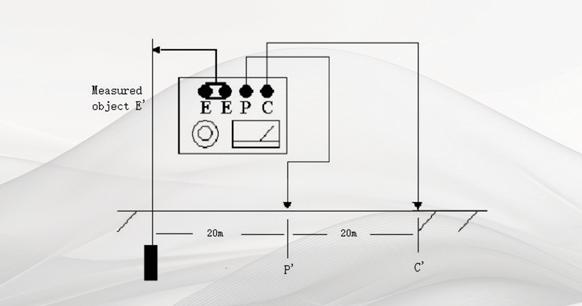
The wiring diagram when the chip resistance is greater than or equal to 1Ω;
When the chip resistance is less than 1Ω, please connect the two E-terminal button wires on the instrument to the ground body under test to eliminate the additional error introduced by the resistance of the connecting wire during the measurement.
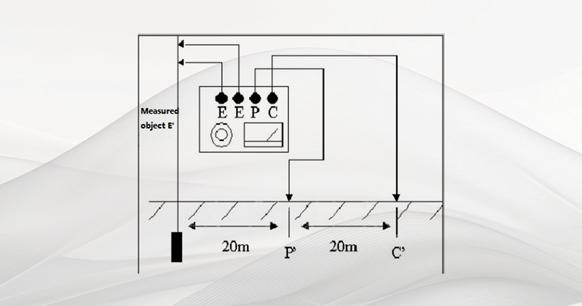
The wiring diagram when the chip resistance is less than 1Ω:
(2) Operation steps:
1) All wiring at the instrument end should be correct.
2) It is essential that the connection between the instrument and the ground electrode E’, potential probe P’, and current probe C’ is secure and in firm contact.
3) Once the meter has been placed horizontally, please adjust the mechanical zero position of the galvanometer and return to zero.
4) Set the "Magnification Switch" to the maximum magnification and gradually increase the speed of the crank handle to 150 RPM. When the galvanometer pointer deflects in a certain direction, please adjust the dial to restore the galvanometer pointer to the "0" point. At this point, the reading on the dial, multiplied by the magnification scale, represents the measured resistance value.
5) If the dial reading is less than 1, it indicates that the galvanometer pointer is still not balanced. In this case, the magnification switch can be set to the next lower magnification until it is adjusted to full balance.
6) Should the pointer of the meter galvanometer be found to be jittery, the speed of the crank can be adjusted to eliminate the jitter.
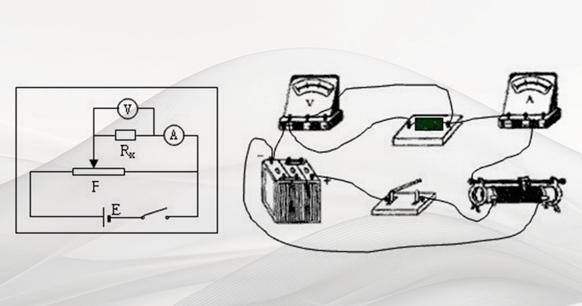
Circuit and physical diagrams
IV. Tolerance
The precision SMD resistor is defined as a chip resistor with a relatively small tolerance. The tolerance is typically 1%. The minimum allowable error is 0.01%. The temperature coefficient is as low as ±5ppm/°C, which is a rare achievement in the industry. This technology can be applied to precision instruments, communication electronic products, and portable electronic products. Many will inquire as to whether the chip resistance is so small that it can be distinguished from 5% and 1% when they are not tested. We will now compare the difference between 5% and 1% chip resistors.
The 5% series SMD resistors are represented by three characters. In this method, the first two digits represent the effective digits of the resistance value, and the third digit represents the number of "0" that should be added after the effective number. When the resistance is less than 10Ω, the letter "R" is used to indicate the position of the decimal point of the resistance value in the resistor code. This notation is typically employed in a resistance series with a resistance value error of 5%. For instance, 330 signifies 33Ω instead of 330Ω; 221 represents 220Ω; 683 denotes 68000Ω or 68kΩ; 105 signifies 1MΩ; 6R2 signifies 6.2Ω.
The 1% series precision SMD resistors are represented by four characters: the first three digits of this notation represent the effective digits of the resistance value, and the fourth digit represents the number of zeroes that should be added after the effective digits. When the resistance is less than 10Ω, the letter "R" is still used in the code to indicate the position of the decimal point of the resistance value. This representation method is typically employed in the precision resistance series with a resistance error of 1%. For example, 0100 represents 10Ω, 1000 represents 100Ω, 4992 represents 49900Ω, or 49.9kΩ, 1473 represents 147000Ω, or 147kΩ, and 0R56 represents 0.56Ω.
The surface of the SMD resistors is engraved with letters. In the event that there are only three digits, the error is 5%. If there are four digits, the error is 1%.
V. Selection of SMD Resistors
Surface-mount technology (SMT) is a highly prevalent manufacturing method, with over 90% of electronic products now assembled using SMT. The development of small-scale SMT production equipment has expanded the application scope of SMT to include aerospace, aerospace, instrumentation, machine tools, and other fields. These industries are now using SMT to produce various small-scale electronic products or components.
Electronic product developers frequently utilize SMD devices to develop new products. In recent years, maintenance personnel have also begun to repair a large number of electronic products assembled by SMT technology.
The model of the SMD resistor is not uniform and is set by each manufacturer. It is particularly long, comprising more than a dozen letters and numbers. Correct presentation of the various parameters and specifications of the SMD resistor at the time of purchase allows for the easy purchase (or ordering) of the required resistor.
There are five parameters for SMD resistors: size, resistance, tolerance, temperature coefficient, and packaging.
1. Size
SMD resistors are available in seven standard sizes, which are identified by two size codes. A size code is an EIA (Electronic Industries Alliance) code represented by four digits. The first two digits and the last two digits indicate the length and width of the resistor in inches, respectively. The other is the metric code, which is also represented by four digits in millimeters. Please note that different size resistors have different power ratings.
2. Resistance
The nominal resistance is determined by the series. Each series is divided by the tolerance of the resistance, with the smallest tolerance resulting in the greatest division of the resistance value. The most commonly used tolerance is E-24, with a tolerance of ±5%.
The surface of the SMD resistor displays three digits representing the resistance value. The first and second digits are valid numbers, while the third digit represents the number followed by zero. When a decimal point is present, use the letter "R" to represent the value and occupy one significant digit.
3. Tolerance
The tolerance of SMD resistors (carbon film resistors) is divided into four levels: F, ±1%; G, ±2%; J, ±5%; and K, ±10%.
4. Temperature Coefficient
The temperature coefficient of the SMD resistor is available in two levels: W, with a coefficient of ±200ppm/°C, and X, with a coefficient of ±100ppm/°C. Only resistors with tolerance class F are grade X, while resistors with tolerances of other grades are generally class W.
5. There are two main types of packaging: bulk and ribbon roll.
SMD resistors are designed to operate within a temperature range of -55 to +125 ℃. The maximum working voltage is dependent on the resistor size. The 0201 size has the lowest voltage rating, while the 0805 size has the highest, at 200V. The 0402 and 0603 sizes have a voltage rating of 50V, and all other sizes fall between these two values.
The digits on the surface of the SMD resistor are used to represent the resistance values in a horizontal format. These values are specified to be represented by three digits, where the first two digits are valid digits and the third digit is an exponent of 10. For example, 473 represents 47,000Ω. If the second character on the resistor surface indicates the resistance value, it represents the decimal point. For instance, 5R1 signifies a resistance value of 5.1Ω.



